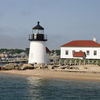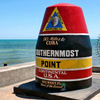Santa Monica, California
By Vicky Gomelsky
Santa Monica’s Ocean Avenue marks the Western terminus of Route 66, the fabled highway that brought millions of pilgrims to California over the years. It’s an apt footnote for a city that was—and still is—one of the west coast’s top destinations.
From the sandstone cliffs beyond that crossroads, Santa Monica seems an obvious playground for celebrities, legions of whom live on its fashionable streets. But you don’t have to be rich and famous to indulge in the city’s charms. On its world-renowned strand, you’ll find a 3.5-mile stretch of bikers, joggers, rollerbladers, yoga masters and grizzly old beach bums engaged in a daily ritual of unapologetic LA-style hedonism. A bit further inland, you’ll also find fine restaurants and stylish boutiques, as well as some truly genre-bending art galleries, where the meaning of contemporary art is continually redefined.
Alternative thinking is part of Santa Monica’s heritage. It was once a bastion of liberalism, home to political activists and 60s radicals who presided over a renter’s paradise of low-cost housing just minutes from the beach. Recently, rent control reform and a fast-moving wave of gentrification have undermined the city’s reputation as “Soviet Monica,” yet it’s still the kind of place where a homeless man might run for city government (as was depicted in the 1998 documentary, Taylor’s Campaign).
To get a true feel for Santa Monica, cruise down the South Bay Bike Trail. The path, installed in 1974, runs for 20-plus miles past a tableau straight out of Baywatch. Begin at Will Rogers State Beach and head south toward the pier, continuing beyond the luxury hotels that line Ocean Front Walk, throwbacks to Santa Monica’s fin de siècle heyday.
The city was founded in July 1875 by John Jones, a wealthy English settler who hoped that it would become an important world port. His dream was dashed 22 years later, when San Pedro won rights to the “Port of Los Angeles.” But the decision proved to be auspicious. Instead of ships, Santa Monica soon attracted millions of beachgoers, inaugurating a golden age of resorts, bathhouses and pleasure piers.
Following WWI, film executives flocked to the coastal community, as did aviation pioneer Donald Douglas, who opened his factory on the present site of the Municipal Airport in 1921. However, it was the construction of ornate beach clubs that shaped Santa Monica’s destiny. By the 1930s, illustrious homeowners, including Mae West and Cary Grant, had bought sand-side property on Santa Monica Beach, which was dubbed the “Gold Coast.”
World War II signaled another turning point for the city, as the economy, propelled by the boom in aeronautics, flourished. The post-war growth continued well into the 1960s, when Downtown was revitalized. In the late 1980s, a $170 million taxpayer-funded campaign helped transform Santa Monica’s coastal zone yet again. The renewal coincided with a decade-long artistic renaissance in the Mid-City area, which welcomed a new arts complex, Bergamot Station. Today, developers share the same goals espoused by their predecessors: Make way for the tourists.
Featured Articles
By Michael A. Hicks The Eiffel Tower looks down upon you with an eye of arrogance, knowing that you are mesmerized and already within its control.
By Malina Brown When Herman Melville immortalized the island of Nantucket in “Moby Dick,” the island was the grubby home to whalers and...
By Jennifer M. O’Brien Full of old Southwestern charm and New Age funk, Sedona, Ariz., dazzles scenery-junkies eager to catch a glimpse of a...
By Brandon Gee Read a typical travel brochure for Key West, Fla. and you will learn of countless tourist attractions―the southernmost point of the continental United...
By Sharon Heilbrunn San Diego hugs the coast with breathtaking beauty, almost as if it humbly accepts its place against the shimmering Pacific Ocean. Beach bums...
Featured Articles
By Michael A. Hicks The Eiffel Tower looks down upon you with an eye of arrogance, knowing that you are mesmerized and already within its control.
By Malina Brown When Herman Melville immortalized the island of Nantucket in “Moby Dick,” the island was the grubby home to whalers and...
By Jennifer M. O’Brien Full of old Southwestern charm and New Age funk, Sedona, Ariz., dazzles scenery-junkies eager to catch a glimpse of a...
By Brandon Gee Read a typical travel brochure for Key West, Fla. and you will learn of countless tourist attractions―the southernmost point of the continental United...
By Sharon Heilbrunn San Diego hugs the coast with breathtaking beauty, almost as if it humbly accepts its place against the shimmering Pacific Ocean. Beach bums...





